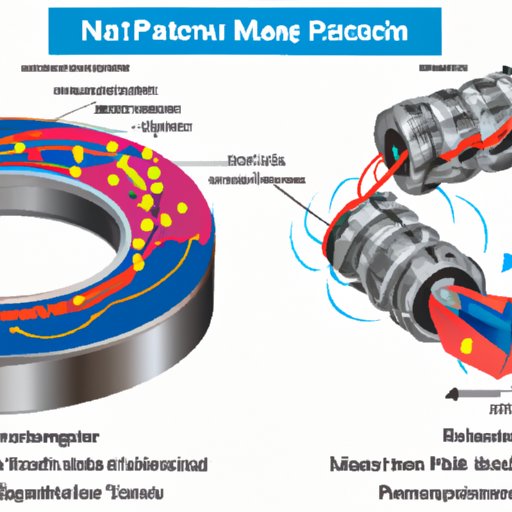
Introduction
Magnetism is a phenomenon that has fascinated people for centuries, from the lodestone compasses used by the ancient Greeks to the modern-day MRI machines used in hospitals. But what exactly is magnetism, and how does it work? In this article, we will explore the physical properties of magnetism, the science behind its behavior, and its essential role in modern technology and everyday life.
Exploring the Fundamentals: An In-Depth Look at Magnetism as a Physical Property
Magnetism is a physical property that refers to the force of attraction or repulsion between certain materials. This attraction or repulsion is caused by the arrangement of electrons within the material. When these electrons are arranged in a way that creates a net magnetic field, the material exhibits magnetic properties.
There are three main types of magnetism: diamagnetism, paramagnetism, and ferromagnetism. Diamagnetic materials, such as copper and silver, have weak magnetic properties and are not attracted to magnets. Paramagnetic materials, such as aluminum and platinum, have slightly stronger magnetic properties and are weakly attracted to magnets. Ferromagnetic materials, such as iron and nickel, have the strongest magnetic properties and are strongly attracted to magnets.
The Science Behind Magnetism’s Physical Properties: A Comprehensive Guide for Beginners
Magnetism is governed by physical laws that describe the relationship between electricity and magnetism. When a charged particle, such as an electron, moves through a magnetic field, it experiences a force that causes it to move in a circular path. This circular motion generates a magnetic field around the particle.
The strength of a magnetic field is measured in units of tesla (T), named after Nikola Tesla, who made important contributions to the study of magnetism and electricity. Magnetic fields can be measured using instruments called magnetometers, which detect the strength and direction of the field. The magnetic field around a magnet is strongest at its poles and weakest in the center.
Magnetic materials are those that can be magnetized, meaning that their electrons can be aligned to create a net magnetic field. Non-magnetic materials, on the other hand, do not contain unpaired electrons and therefore cannot be magnetized.
Separating Fact from Fiction: Magnetism’s Physical Properties Debunked
There are many misconceptions about magnetism that have been perpetuated over the years. One of the most common is the belief that magnets have a north pole and a south pole because they contain tiny magnets inside them. In reality, the north and south poles of a magnet are simply the two ends of the magnetic field that the magnet generates.
Another misconception is that magnets can be used to cure diseases or heal physical ailments. While magnets can provide some relief for certain conditions, such as joint pain, there is no scientific evidence to support the idea that they can cure diseases or promote healing.
From Bar Magnets to Superconductors: Investigating Magnetism’s Physical Properties in Different Materials
Many different materials exhibit magnetic properties, from everyday objects such as refrigerator magnets to high-tech materials such as superconductors. The behavior of these materials varies depending on their composition and structure.
One common type of magnet is the bar magnet, which has a north pole and a south pole. When two bar magnets are brought together, the north pole of one magnet will be attracted to the south pole of the other magnet, while the north pole of one magnet will repel the north pole of the other magnet. This attraction or repulsion is caused by the interaction of the magnetic fields around the magnets.
Superconductors, on the other hand, are a class of materials that exhibit zero electrical resistance and perfect diamagnetism when cooled to very low temperatures. This means that they can be used to create extremely strong magnetic fields without losing energy to heat, making them useful for a variety of applications such as MRI machines and particle accelerators.
Magnetism: The Essential Physical Property for Modern Technology and Everyday Life
Magnetism is essential to many of the technologies that we rely on every day, from electric motors and generators to hard drives and credit card readers. Without magnetism, it would be difficult to imagine a world with smartphones, computers, and other electronic devices.
Some everyday items that rely on magnetism include refrigerator magnets, compasses, and speaker systems. In the medical field, magnetism is used in MRI machines to produce detailed images of the inside of the body. In the transportation industry, magnets are used in bullet trains to levitate the train and reduce friction.
Magnetism’s Physical Properties: Paving the Way for Future Innovations and Discoveries
Current research on magnetism is focused on developing new materials and technologies that can harness its power. For example, scientists are investigating the use of magnetism in spintronics, a field that uses the magnetic properties of electrons to store and process information.
Researchers are also exploring the use of magnetism in fields such as energy storage, data storage, and quantum computing. The potential applications of magnetism are vast, and continued research in this field is sure to yield many exciting discoveries and innovations in the years to come.
Conclusion
Magnetism is a fascinating and essential physical property that has a wide range of applications in science and technology. By understanding the basic principles of magnetism, we can gain a deeper appreciation for the role it plays in our everyday lives. Whether we are using a simple refrigerator magnet or a complex MRI machine, magnetism is an important part of the world around us.




